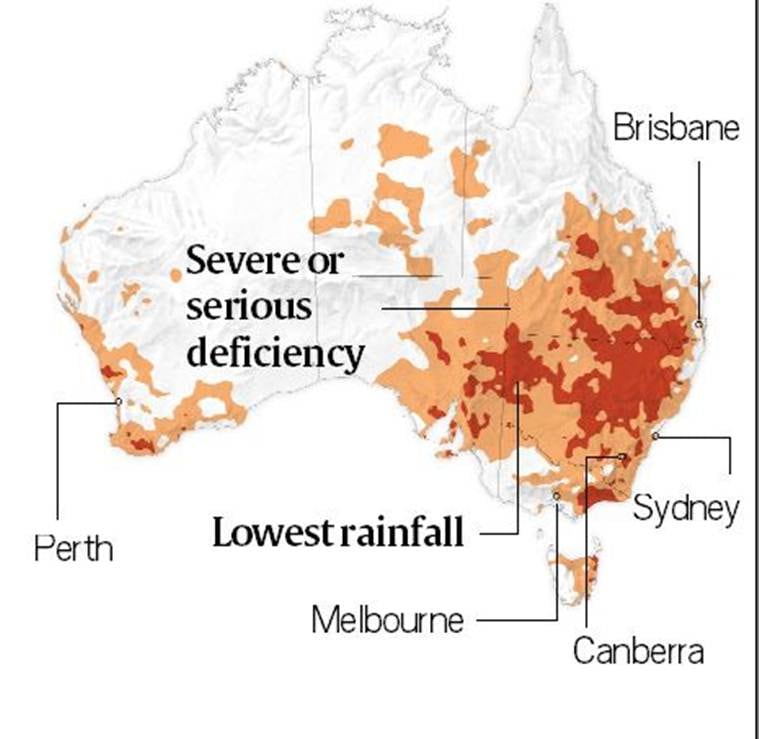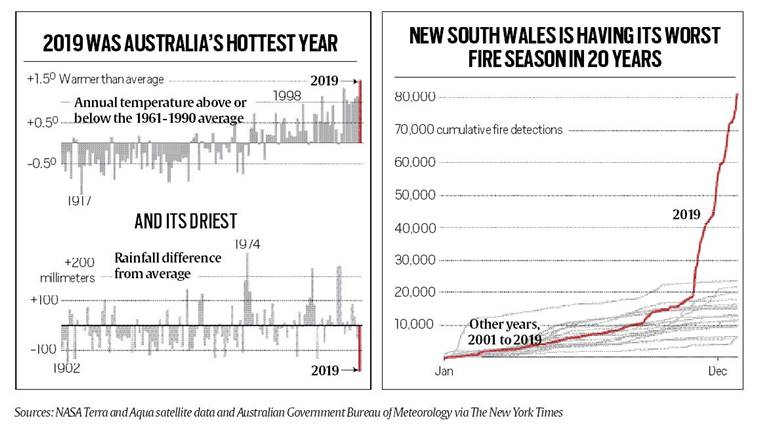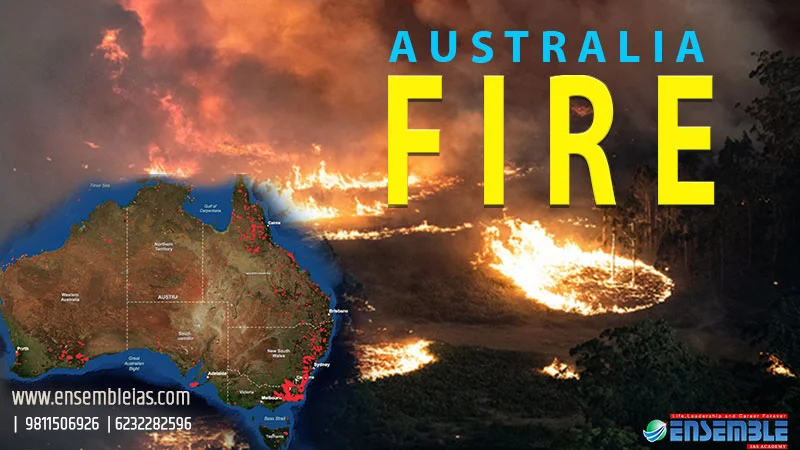Australia Fire : Forest fires are routine during the Australian summer, but what’s happening now is on an unprecedented scale. A look at the extent of damage, and how the likely causes bear out long-time climate concerns.
or more than three weeks now, striking photographs from Australian towns and villages, bathed in an orange background, have been making global headlines, and circulating on social media. The gloomy orange background is because of smoke from an unprecedented spate of forest fires in large parts of Australia for more than three months now.
Forest fires, or bushfires as they are known in some parts of the world, are common occurrences in Australia during the summer season, but the scale and intensity this year have been extraordinary, and scientists are already attributing it to climate change. Many of them are warning that the scenes from Australia could be a glimpse of the future that awaits our planet if urgent action is not initiated on climate change.
What causes forest fires?
Forest fires, or wildfires, routinely occur across the world in hot and dry seasons. Dry leaves, grass, shrubs, deadwood etc are easily combustible. Ignition happens naturally, from lightning strikes for example, or accidentally, from sources such as cigarette stubs. Suitable speed and direction of wind helps spread a forest fire faster. It usually comes to an end due to rain or because there is no further contiguous vegetation to spread to.
Sometimes, fires are ignited on purpose, either to clear the land, or even to control an incoming forest fire by removing vegetation that would have aided the incoming fire’s further spread.
Last year, the fires in the Amazon forests in Brazil had become controversial because they were largely seen to have been a result of deliberate burning by farmers and large agro-industry players keen on getting more land. Major forest fires were reported last year in the US, Canada and Europe too. During the summer months, fires are common in the forests of India as well, though their scale and impact are much smaller.


How common are forest fires in Australia?
Australia, where the summer starts around October, is known to be the most fire-prone of all continents. This is mainly because Australia is also the driest inhabited continent. Almost 70 per cent of its area comprises arid or semi-arid land, with average annual rainfall less than 350 mm, according to the Australian government’s Department of Environment and Energy.
Australia has about 134 million hectares of forest land, most of it in the north and east. Bushfires are pretty common every year in summer. Australian government data show that about 55 million hectares of forest land, more than 40 per cent of the entire forests, had been affected by at least one such fire in the period between 2011 and 2016.
So, how are the ongoing fires different?
This Australian summer, the spread and intensity of forest fires are something never seen before. According to a Reuters report earlier this week, the fire has impacted more than 10.3 million hectares of forest land so far, an area the size of South Korea. Twenty-seven people have so far died, while reports suggest millions of wild animals might have been killed. Australia’s Environment Minister said up to 30 percent of the koala population was feared to have perished in the fires.
Several record-breaking weather conditions are believed to have contributed to this unprecedented wave of forest fires. The Australian Bureau of Meteorology confirmed on Thursday that 2019 happened to be the warmest and driest year for the country since 1900. Daytime temperatures were, on an average, 2°C higher than normal, while average rainfall for the country was 40% below normal. Heat and dryness are the key preconditions for the Australia is in the midst of a prolonged drought, now spreading to three consecutive years. The three years between 2017 and 2019 were the driest 36-month period ever in the Murray-Darling Basin and New South Wales. For last year at least, the problem has been compounded by the presence of one of the strongest-ever positive Indian Ocean Dipole (IOD) events. The IOD, which refers to the difference in sea-surface temperatures in the eastern and western Indian Ocean, either aids or cuts off moisture supply to Australia, depending on whether the western Indian Ocean is cooler or the eastern. This year, the eastern Indian Ocean has been unusually cold, and that contributed to the rainfall deficiency over Australia.

Another indicator of the extent of dryness this year is the condition of soil moisture which is at historic lows in the areas most affected by the fires. Scientists also point to a rare stratospheric warming over Antarctica — temperatures were 30°C to 40°C higher than normal in the region 10 to 50 km from Earth’s surface — as yet another extraordinary weather event that could have contributed to the unusual heat and dryness in Australia.
Visit our store at http://online.ensemble.net.in
Can it be attributed to climate change?
Usually, scientists are wary of attributing any single contemporary event to climate change, mainly because of the difficulty in completely ruling out the possibility of the event having been caused by some other reason, or a result of natural variability. In this case, however, there is strong evidence to indicate that nearly all the drivers of the extraordinary heat and dryness in Australia, which has led to these unprecedented forest fires, could directly be linked to climate change.
The warming trend that made 2019 the warmest year on record for Australia, the prolonged drought, severe rainfall deficiencies, the strongly positive IOD and low soil moisture can all be easily attributed to climate change.
More significantly, exactly these kinds of bushfires, of higher intensity and wider spread, have been predicted by climate change studies in the past. As far back as 2007, the Intergovernmental Panel on Climate Change (IPCC) had said in its fourth assessment report that climate change was likely to increase the frequency of fires in Australia. This has been re-emphasised in all recent IPCC reports.
“In south-east Australia, the frequency of very high and extreme fire danger days is likely to rise by four to 25 per cent by 2020 and 15 to 70 per cent by 2050,” the IPCC report had said in its 2007 report. The fiercest fires this season have also been concentrated in south-east Australia. “In both Australia and New Zealand, the fire season length is likely to be extended.” the report had said.
View our Blog: https://ensembleias.com/blog/
The Australian bushfires are therefore being seen as one of the biggest climate disasters of our times. And it is likely to intensify even further, considering that the Australian summer is not yet over. Thousands of people have already been rendered homeless, and Australian authorities, on Thursday, told the people to be ready for more mass evacuations, particularly those living in the southeastern parts where the fires have caused the maximum devastation.
Source: Indian Express | Written by Amitabh Sinha
For more details : Ensemble IAS Academy Call Us : +91 98115 06926, +91 7042036287
Email: [email protected] Visit us:- https://ensembleias.com/
#climate #disasters #australia #fire #soil_moisture #blog #current_affairs #daily_updates #free #editorial #geographyoptional #upsc2020 #ias #k_siddharthasir #ensembleiasacademy





